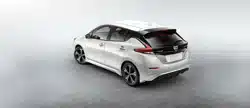Loading ...
Loading ...
Loading ...

The time to completely charge the vehicle
Li-ion battery varies based on the state of
charge of the Li-ion battery, condition and
age of the Li-ion battery, temperature of
the Li-ion battery, ambient temperature
and condition of the power source con-
nected to the vehicle, and whether the
electric equipment (such as the air condi-
tioner, which consumes electric power) is
used.
Normal charge
NISSAN recommends using normal charg-
ing for usual charging of the vehicle. Use of
quick charge should be minimized in order
to help prolong Li-ion battery life.
Normal charging uses L1 & L2 EVSE (Electric
Vehicle Supply Equipment), or an SAE J1772
compliant charging device connected to a
dedicated AC 220 - 240 volt circuit. L1 & L2
EVSE is provided with the vehicle (if so
equipped). The charging device is a home
charging dock installed in your home by a
qualified electrician. Contact your NISSAN
certified LEAF dealer. For additional infor-
mation, see “How to normal charge”
(P. CH-9).
Trickle charge
Trickle charging is not recommended for
regular use because it takes more time
than normal charging. Trickle charge can
be used when it is necessary to perform an
emergency charge at a destination such
as a friend’s house.
Trickle charge uses the EVSE (Electric Ve-
hicle Supply Equipment) provided with the
vehicle or an SAE J1772 compliant cord set
to connect the vehicle to an AC 110–120 volt,
15A dedicated outlet. The outlet should be
protected by a circuit breaker to avoid
overloading the circuit or other electrical
hazard.
For additional information, see “How to
trickle charge” (P. CH-11) or (P. CH-18).
Quick charge (if so equipped)
Quick charge capability is only available on
vehicles manufactured with the quick
charge option, which includes the quick
charge port. If your vehicle does not have
such a port, quick charging cannot be
used.
A vehicle equipped with a quick charge
port is compatible with most CHAdeMO
(Japanese industry standard) connectors
on charging stations. Charging stations
using this standard are UL certified and
safe to use in the US. While supported by
NISSAN, this connector may not become
the US SAE standard.
Quick charging is possible (even several
times a day). If the battery temperature is
near the red zone, in order to protect the
battery, power of the quick charging will be
limited.
Public charging:
This vehicle is compatible with any public
charging station that is SAE J1772 compli-
ant. If you attempt to charge from a non-
compliant charging station, you may not
receive a complete charge, or you may not
be able to charge at all due to hardware
and software differences. NISSAN is work-
ing with states, municipalities, utility com-
panies and others to assist in the prepara-
tion of markets and infrastructure.
However, NISSAN makes no representa-
tions that public charging stations will be
available in locations where you wish to
operate the vehicle, nor can NISSAN predict
the period of time it may take for public
charging infrastructure to be developed in
your area. Depending on where you live or
drive, there may not be sufficient public
charging stations available to meet your
particular needs for driving range and
charging away from your home. Trip plan-
ning is therefore important, and you should
plan trips with these facts in mind.
Charging CH-7
Loading ...
Loading ...
Loading ...
